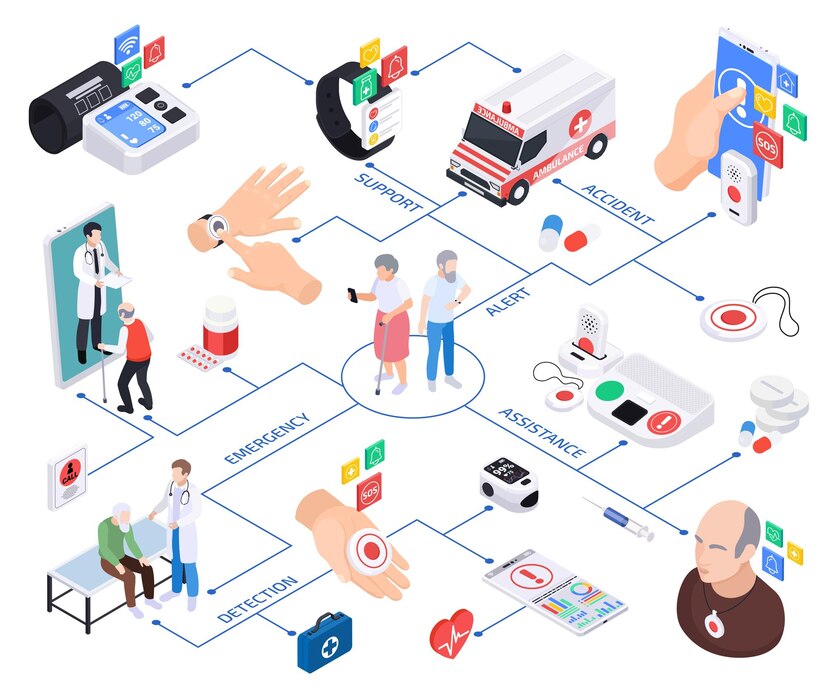Artificial Intelligence (AI) is becoming an indispensable tool in emergency medicine, transforming how emergency departments (EDs) operate and deliver care. By harnessing the power of AI, healthcare providers can improve diagnostic accuracy, optimize patient triage, and enhance overall patient outcomes. This article delves into the various applications of AI in emergency medicine, highlighting its benefits and the challenges encountered in its integration.
Applications of AI in Emergency Medicine
Diagnostic Accuracy:
AI algorithms can analyze vast amounts of medical data quickly and accurately, aiding in the diagnosis of various conditions. In emergency medicine, where rapid and precise diagnosis is crucial, AI can assist in interpreting imaging studies such as X-rays, CT scans, and MRIs, reducing the likelihood of human error and ensuring timely intervention.
Patient Triage:
AI-powered triage systems can assess patient symptoms and vital signs to prioritize cases based on severity. These systems use machine learning to analyze historical data and predict which patients need immediate attention, streamlining the triage process and reducing wait times.
Predictive Analytics:
AI can predict patient outcomes by analyzing patterns in data. For instance, AI models can forecast the likelihood of patient deterioration, enabling healthcare providers to intervene proactively. This predictive capability is particularly valuable in emergency settings, where timely decisions can save lives.
Resource Allocation:
AI helps optimize resource allocation in emergency departments by predicting patient influx and identifying peak times. This enables better staffing and resource management, ensuring that EDs are prepared to handle high volumes of patients efficiently.
Telemedicine Integration:
AI can enhance telemedicine services in emergency medicine by providing real-time data analysis and decision support. During virtual consultations, AI algorithms can assist in diagnosing conditions and recommending treatment plans, improving the quality of remote care.
Benefits of AI in Emergency Medicine
Improved Patient Outcomes:
AI enhances the accuracy and speed of diagnosis, leading to more effective and timely treatments. This reduces the risk of complications and improves overall patient outcomes, particularly in time-sensitive emergencies.
Efficiency and Workflow Optimization:
AI streamlines workflows by automating routine tasks such as data entry, patient monitoring, and resource management. This allows healthcare providers to focus more on direct patient care, improving the efficiency of emergency departments.
Reduced Diagnostic Errors:
By providing decision support and cross-referencing vast medical data, AI minimizes the risk of diagnostic errors. This is particularly important in emergency medicine, where accurate diagnoses are critical for patient survival.
Enhanced Data Utilization:
AI leverages big data to provide insights that would be challenging to obtain manually. By analyzing patient histories, treatment outcomes, and real-time data, AI supports evidence-based decision-making and personalized care.
Challenges in Implementing AI in Emergency Medicine
Data Privacy and Security:
The integration of AI in emergency medicine raises concerns about data privacy and security. Ensuring that patient data is protected and used ethically is crucial for maintaining trust and complying with regulations such as HIPAA.
Algorithm Bias:
AI algorithms can inherit biases present in the training data, leading to disparities in care. Addressing algorithmic bias and ensuring fairness in AI applications is essential to provide equitable healthcare.
Integration with Existing Systems:
Incorporating AI into existing healthcare infrastructure can be complex and costly. Seamless integration requires collaboration between technology providers and healthcare organizations, as well as significant investment in training and system upgrades.
Regulatory and Ethical Considerations:
The use of AI in emergency medicine must comply with regulatory standards and ethical guidelines. Establishing clear regulations and ethical frameworks is necessary to govern the development and deployment of AI technologies.
Future Directions
Continued Research and Development:
Ongoing research is essential to advance AI technologies and address current limitations. By investing in research and development, the healthcare industry can refine AI applications and enhance their effectiveness in emergency medicine.
Collaboration and Education:
Collaboration between AI developers, healthcare providers, and policymakers is crucial for successful implementation. Additionally, educating healthcare professionals about AI and its applications will facilitate smoother integration and adoption.
Personalized Medicine:
AI has the potential to support personalized medicine by tailoring treatments to individual patient needs. In emergency medicine, this could involve customizing interventions based on patient-specific data and predicted outcomes.
Integration of AI with Other Technologies:
Combining AI with other emerging technologies such as wearable devices, Internet of Things (IoT), and blockchain can further enhance emergency care. These integrations can provide comprehensive real-time monitoring, secure data sharing, and improved patient outcomes.
AI is poised to revolutionize emergency medicine by improving diagnostic accuracy, optimizing patient triage, and enhancing overall efficiency. Despite the challenges associated with its implementation, the benefits of AI in emergency medicine are substantial, offering the potential for improved patient outcomes and more effective emergency care. As technology continues to evolve, AI will play an increasingly vital role in shaping the future of emergency medicine.




